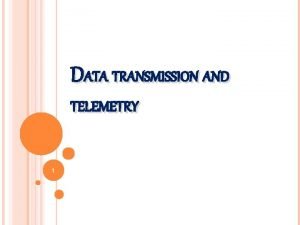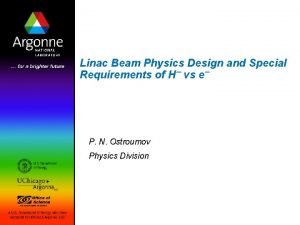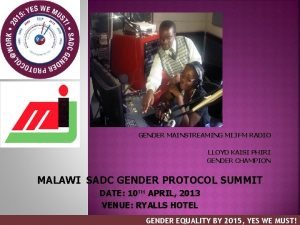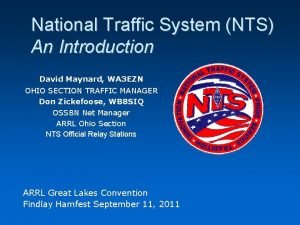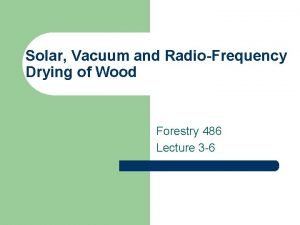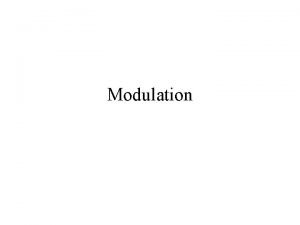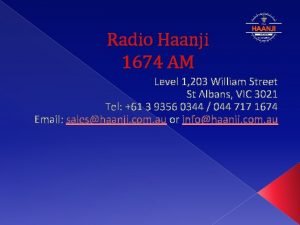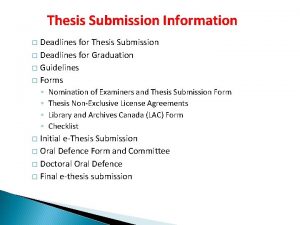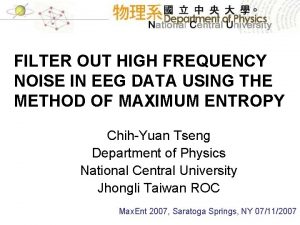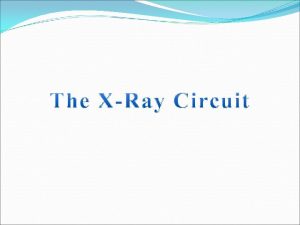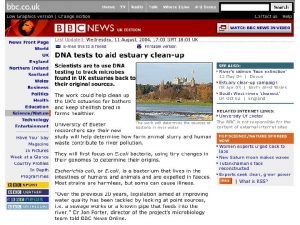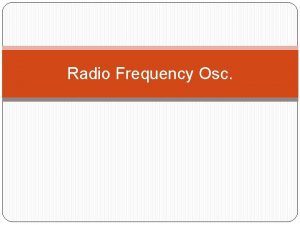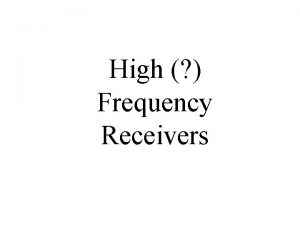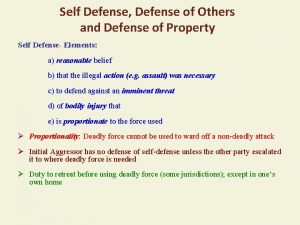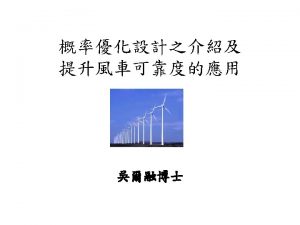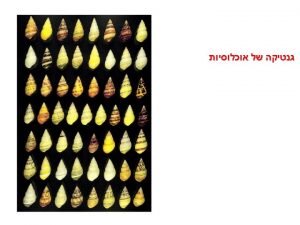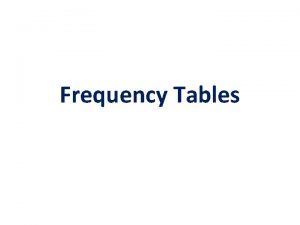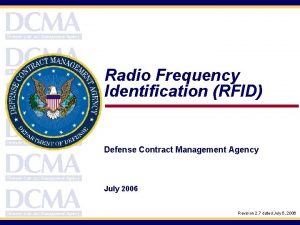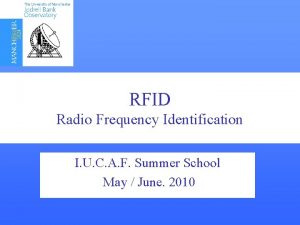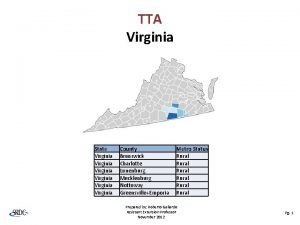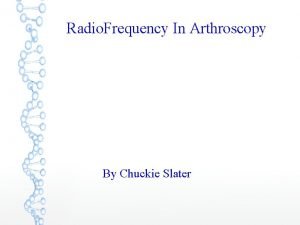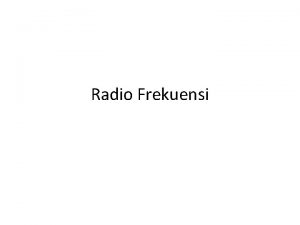Introduction To High Frequency Radio Virginia Defense Force
































- Slides: 32

Introduction To High Frequency Radio Virginia Defense Force 1

Introduction • TASK: To aid personnel in using high-frequency (HF) radio systems to achieve successful communications. • CONDITION: The individual is provided with classroom training, documentation, and equipment. • STANDARD: Standard is met when personnel can successfully identify the basic components of an HF system, put the components into operation, and make a communications check. 2

Introduction • RISK ASSESMENT: Moderate • SAFETY CONSIDERATIONS: Do not permit antennas to come into contact with high power lines or other sources of electricity. IT CAN CAUSE INJURY OR DEATH. DO NOT install antennas or operate equipment during thunderstorms or high winds. 3

Introduction • What is an HF radio system? • What are the characteristics, frequencies, and capabilities of an HF system? • When to utilize HF communications. • How to assemble an HF system. 4

What Is HF Radio? • HF is an abbreviation for High Frequency. • High Frequency is a term used to describe the 1. 6 MHz. To 30 MHz. Portion of the radio spectrum. • This range of frequencies can provide both short-range and long-haul communications. • In the Va. DF HF will typically be used for beyond line of site communications with a range of apox. 250 miles. 5

Radio Frequency Band Designations • 30 -300 Hz . . . ELF (extremely low frequency) 300 -3000 Hz. . . . …(voice / hearing range) 3 -30 k. Hz . . . VLF (very low frequency) 30 -300 k. Hz . . LF (low frequency) 300 -3000 k. Hz . . MF (medium frequency) 3 -30 MHz. . . . . HF (high frequency) 30 -300 MHz. . VHF (very high frequency) 300 -3000 MHz. . UHF (ultra high frequency) 3 -30 GHz. . . SHF (super high frequency) 30 -300 GHz EHF(extremely high frequency) 6

Modes of Operation • Radios use various modes of operation to convey information in a signal. • There are three basic modes used in HF operation. • SSB voice: USB (upper side band), LSB (lower side band). • CW: (continuous wave) more commonly known as Morse code. • Data: there are many different data modes in use today. 7

Modes of Operation • With data communications signals are received and processed by a computer to display text, pictures, files, E-mail, etc. • One type of data mode that has been used by the Va. DF is PSK 31. • PSK 31 is similar to instant messaging. 8

Modes of Operation • In the VDF, the primary mode of operation on HF will be USB (upper side band) voice on all frequencies. • LSB operation under certain conditions will be used, only when authorized by the NCS (Net Control Station). 9

Putting the HF Station Together • There are four basic things needed to assemble an HF station: • HF transceiver • Power source • Cabling • Antenna 10

Power Sources • Most modern day HF transceivers can operate from 12 VDC. • This is very convenient when operating in an emergency operation where commercial power or fuel for a generator might be in short supply. • When commercial power or generator is available, a 12 VDC power supply can be used. • The HF radios that the Va. DF will use require an external power source. 11

External Type Power Supply 12

HF Radios used by the VDF • The Micom 3 t is the HF radio That is installed in the mobile communication trailers. • The Micom 3 t is an advanced HF transceiver, can provide Voice, data, Fax, and E-mail over HF with appropriate accessories. • The 3 t is ALE capable. • High Frequency Radio Teams use the Icom M 700/710 Pro Marine radios. 13

icom – IC-M 700 14

Back View icom – IC-M 700 15

icom-IC-M 710 16

• Back View icom – M 710 17

Cabling, Coax, Connectors • Coax is the link between your transceiver and the antenna. The coax carries the signal from the radio to the antenna. • Coaxial cable consists of two concentric conductors with insulation in the space between the conductors. The inner conductor carries the signal (i. e. it is "hot") and the outer conductor is usually “ground” and acts as a shield. RG 8 and RG 213 are two recommended types of 50 Ohm coax. • Coax type is printed on the outside of the cable. • In addition to coax, other cables will be required to connect the transceiver to the power source and any additional accessories. • A good heavy (10 ga. or better) solid copper wire will be needed to connect your station to a good earth ground. 18

Cabling, Coax, Connectors Grounding Rod PL 259 Coax Connectors BNC Connector Typical Coax Cable RG 213 Typical Power Cable 19

Antennas • An antenna is a devices that picks up or sends out radio waves. • The transmitter generates radio frequency energy. This energy is converted into radio waves with an antenna. • An antenna works the other way also. When a radio wave crosses an antenna, it generates a voltage in the antenna. • This voltage travels through the coax to the radio. • The same antenna will be used for transmitting and receiving. 20

Antennas • There are many types of HF antennas. In order to establish reliable communications in the AO (Area of Operation), the correct type of antenna must be chosen. • For HF communications that the Va. DF will be tasked with, a standard half wavelength dipole configured to utilize NVIS (near vertical incidence skywave) techniques will be the best choice. (More on NVIS later). • Vertical antennas because of their characteristics are not suitable for other than LOS (Line of Site) HF communications. 21

Antennas / Important Properties • Antennas are classified as either resonant or nonresonant. • An antenna should be tuned to the frequency you are using, much like tuning the strings on a guitar are tuned to certain notes. • If an antenna is fed with a frequency other than the one it was tuned for, much of the signal will be lost. • A resonant antenna will effectively radiate a signal for frequencies close to the one it was tuned for. • The fundamental antenna is the dipole. 22

Antennas / Dipole Typical dipole installations showing two ways to put up a dipole, horizontal and inverted. 23

Antennas • Tuning the antenna for the frequency of operation can be done in two ways: • Physically matching (or tuning) the length of the antenna to the frequency being used. • Electrically matching the antenna to the frequency with an antenna tuner. • The length of a half-wave dipole antenna can be calculated by dividing 468 by the frequency you want to operate on. This will give you the full length of the antenna in feet. 24

Antennas • The Barker and Williamson broad band folded dipole is one the type antenna the VDF will be utilizing for use with the mobile command posts. • Due to its design, an antenna tuner is not required. • Works well for NVIS techniques and ALE applications where frequencies are changed at an extremely rapid rate. 25

Antennas Barker & Williamson Antenna (Shown rolled up) 26

Antennas Barker & Williamson Antenna (Typical application) 27

Putting It All Together • As stated earlier, there are four basic components needed to assemble an HF station. • Transceiver • Power Source • Cabling • Antenna 28

Precautions • As with any transceiver, never key the microphone until the antenna is in place and connected. Damage to the equipment can result. • Make sure there are no personnel working on the antenna before the microphone is keyed. Serious RF burns to personnel can result. • If not sure, do not key the microphone. Go and look. 29

Putting It All Together • Reference picture in handout. 30

• Questions? ? ? 31

• TAKE A 10 MINUTE BREAK 32
 What are the first line of defense
What are the first line of defense Seo northern virginia
Seo northern virginia Awin support
Awin support Landline telemetry system
Landline telemetry system Radio frequency quadrupole
Radio frequency quadrupole Mij fm radio malawi online
Mij fm radio malawi online Nts radio frequency
Nts radio frequency Radio frequency identification
Radio frequency identification Radio frequency identification
Radio frequency identification Radio frequency vacuum dry kiln
Radio frequency vacuum dry kiln Radio haanji
Radio haanji Fm and am
Fm and am Radio frequency design and technology
Radio frequency design and technology Radio frequency antenna
Radio frequency antenna Radio haanji frequency
Radio haanji frequency How to find conditional relative frequencies
How to find conditional relative frequencies Observed frequency
Observed frequency Average of sine wave
Average of sine wave How is linear frequency related to angular frequency?
How is linear frequency related to angular frequency? Frequency vs relative frequency
Frequency vs relative frequency Joint frequency vs marginal frequency
Joint frequency vs marginal frequency Relative frequency two way table
Relative frequency two way table Thesis submission deadline mcgill
Thesis submission deadline mcgill Virginia tech high school programming contest
Virginia tech high school programming contest Virginia tech high school programming contest
Virginia tech high school programming contest Low amplitude wave
Low amplitude wave H
H Botulims
Botulims High frequency letters
High frequency letters High frequency filter eeg
High frequency filter eeg Falling load generator
Falling load generator High frequency structure simulator
High frequency structure simulator Hfr bacteria
Hfr bacteria



